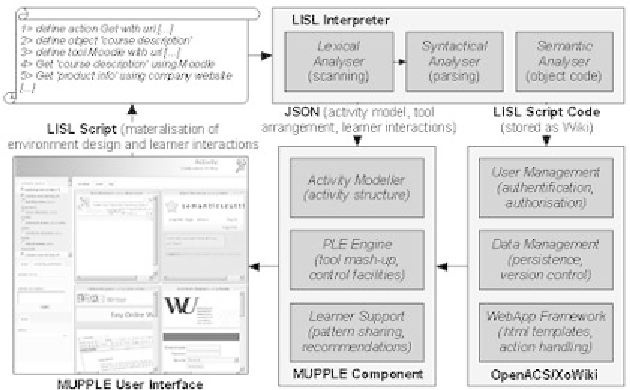Information Technology Reference
In-Depth Information
the latest version of the model and the last state
of the mash-up space, before this information is
transferred via a JS-based API to the browser.
Updates are made incrementally, so that learners
(facilitators and peers) can execute single lines of
code at any time by either typing them in manually
or by using the web-based widgets.
Overall, we have realized the MUPPLE ap-
proach according to the 14 design guidelines for
end-user development given by Repenning &
Ioannidou (2006). As a result, learners are sup-
ported in designing their learning environment in
the form of tool mash-ups for each activity they
are involved at. The syntactic guidelines ensure
that errors are prohibited whenever possible and
explained to the end-user if necessary. The se-
mantic guidelines justify the simplicity of our
activity model as well as web-based control fa-
cilities for designing and using the tool mash-up
in a comfortable way. Finally, the pragmatical
guidelines deal with the incremental development
of the learning environment, with reusing and
testing these prototypes designed by learners, with
the possibility to modify the script manually, and
with scaffolding designs and community-based
activities.
Concerning privacy, a MUPPLE page is con-
sidered to be accessible only by the owner (and
system-wide administrators). Parts of the pages
are subject to semantic analysis, e.g. for action-
outcome-tool recommendations), or can be shared
by the learners with other users, e.g. through the
generation of activity patterns; both approaches
will be explained in the following.
Example: Collaborative Writing
The educational approach of MUPPLE aims at
supporting lifelong learners and stresses methods
to build up and sustain a learning network of ac-
tors, artefacts, and activities, which increase the
motivation to learn and aims at developing more
complex competencies (cf. Koper & Olivier,
2004). Similar to web 2.0-driven platforms like
Facebook, learners require facilities to get in-
volved into collaborative activities and to regulate
collaboration and social interactions with peers.
To illustrate the MUPPLE approach and the
utilization of the design language we introduced in
the previous section, the following part describes
an in-depth scenario and an outline of how the
personal learning environment constructed in this
Figure 6. Architecture of MUPPLE

Search WWH ::

Custom Search